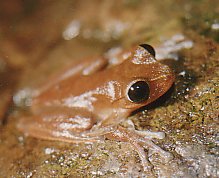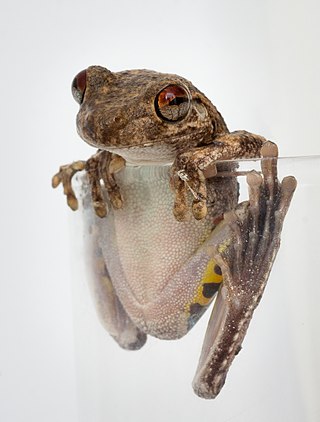
Litoria is a genus of hylid tree frogs, sometimes collectively referred to as Australasian treefrogs.

Nyctimystes is a genus of tree frogs in the subfamily Pelodryadinae of the family Hylidae. They are principally Papuan species, but also inhabit islands in the Moluccas. All species in this genus have one distinct feature that separates them from other species in the family, the lower eyelid is marked with pattern of lines, veins, or dots. This feature presumably acts as camouflage when the frogs are at rest during the day.

The Australian green tree frog, also known as simply green tree frog in Australia, White's tree frog, or dumpy tree frog, is a species of tree frog native to Australia and New Guinea, with introduced populations in the United States and New Zealand, though the latter is believed to have died out. It is morphologically similar to some other members of its genus, particularly the magnificent tree frog (R. splendida) and the white-lipped tree frog (R. infrafrenata).

The white-lipped tree frog is a species of frog in the subfamily Pelodryadinae. It is the world's largest tree frog and is found in Australia. Other common names include the New Guinea treefrog, giant tree frog, and Australian giant treefrog.

Amphibians of Australia are limited to members of the order Anura, commonly known as frogs. All Australian frogs are in the suborder Neobatrachia, also known as the modern frogs, which make up the largest proportion of extant frog species. About 230 of the 5,280 species of frog are native to Australia with 93% of them endemic. Compared with other continents, species diversity is low, and may be related to the climate of most of the Australian continent. There are two known invasive amphibians, the cane toad and the smooth newt.

Roth's tree frog, or the northern laughing tree frog, is a species of tree frog native to northern Australia and southern Papua New Guinea. Roth's tree frog is a common frog, closely related to Peron's tree frog and Tyler's tree frog.
The northern New Guinea tree frog is a species of frog in the subfamily Pelodryadinae. It is endemic to the Bird's Tail Peninsula. Its natural habitats are subtropical or tropical moist lowland forests and subtropical or tropical moist montane forests. It is threatened by habitat loss.
Djoko Tjahjono Iskandar is an Indonesian herpetologist who studies the amphibians of Southeast Asia and Australasia. He is a professor of biosystematics and ecology at Bandung Institute of Technology in West Java, Indonesia.
Nyctimystes dux is a species of frog in the subfamily Pelodryadinae. This fairly large tree frog is mainly green. It is endemic to the Huon Peninsula in Papua New Guinea. It was separated from Litoria graminea by Richards & Oliver, 2006.
Nyctimystes purpureolatus is a species of frog in the subfamily Pelodryadinae. It is endemic to New Guinea and is known from its type locality on the Tiri River, a small tributary of the Mamberamo River in West Papua, Indonesia, and from three locations in West Sepik Province, Papua New Guinea.
Litoria spartacus is a species of frog in the subfamily Pelodryadinae of the family Hylidae. It is endemic to Papua New Guinea and is only known from two localities within the Kikori Integrate Conservation and Development Project Area in the Southern Highlands Province. It has affinities to Litoria macki and Litoria spinifera but has a smaller size and more extensively webbed hands and less tuberculate body.

Ranoidea mira, also known as the chocolate frog, is a species of tree frog in the subfamily Pelodryadinae, and is part of the Ranoidea caerulea species complex. It was discovered in New Guinea by a research team led by Griffith University.
The parachuting frog, or pale-eyed parachuting tree frog, is a species of frog found in New Guinea. It is in the Nyctimystes gramineus complex with the Pinocchio frog and montane Pinocchio frog.
Nyctimystes sauroni is a species of tree frog in the subfamily Pelodryadinae. It is endemic to Papua New Guinea. Scientists know it solely from the Kikori Integrate Conservation and Development Project area.
Litoria viranula is a species of frog in the family Hylidae, endemic to New Guinea. It is in the same species group with Litoria bicolor.
Nyctimystes pallidofemora is a species of tree frog in the subfamily Pelodryadinae, endemic to Papua New Guinea. Scientists disagree about whether this frog is best placed in the genus Nyctimystes or the genus Litoria.
Nyctimystes nullicedens is a species of tree frog in the subfamily Pelodryadinae. It is endemic to Papua New Guinea and has been found on the south-western side of Mount Obree, at 550 meters above sea level.
Nyctimystes kuduki is a species of tree frog in the sub-family Pelodryadinae. It is endemic to Papua New Guinea and is found in montane rainforests in Southern Highlands Province.
Litoria amnicola, the Raja Ampat torrent tree frog, is a frog in the family Hylidae, endemic to Indonesia. It has been found on Salawati Island, which is in the Raja Ampat archipelago.







